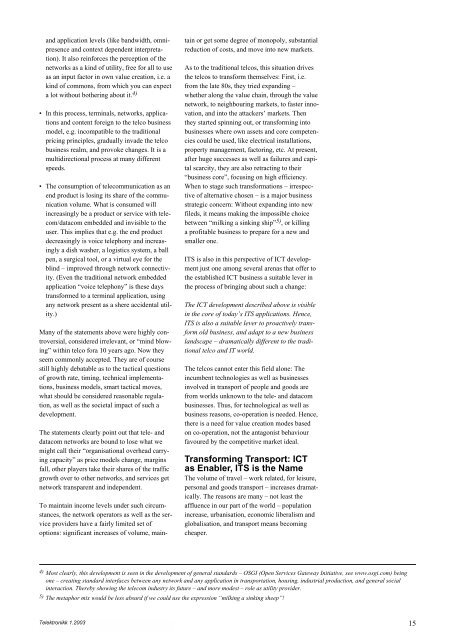Intelligent Transport Systems - Telenor
Intelligent Transport Systems - Telenor
Intelligent Transport Systems - Telenor
Create successful ePaper yourself
Turn your PDF publications into a flip-book with our unique Google optimized e-Paper software.
and application levels (like bandwidth, omnipresence<br />
and context dependent interpretation).<br />
It also reinforces the perception of the<br />
networks as a kind of utility, free for all to use<br />
as an input factor in own value creation, i.e. a<br />
kind of commons, from which you can expect<br />
a lot without bothering about it. 4)<br />
• In this process, terminals, networks, applications<br />
and content foreign to the telco business<br />
model, e.g. incompatible to the traditional<br />
pricing principles, gradually invade the telco<br />
business realm, and provoke changes. It is a<br />
multidirectional process at many different<br />
speeds.<br />
• The consumption of telecommunication as an<br />
end product is losing its share of the communication<br />
volume. What is consumed will<br />
increasingly be a product or service with telecom/datacom<br />
embedded and invisible to the<br />
user. This implies that e.g. the end product<br />
decreasingly is voice telephony and increasingly<br />
a dish washer, a logistics system, a ball<br />
pen, a surgical tool, or a virtual eye for the<br />
blind – improved through network connectivity.<br />
(Even the traditional network embedded<br />
application “voice telephony” is these days<br />
transformed to a terminal application, using<br />
any network present as a shere accidental utility.)<br />
Many of the statements above were highly controversial,<br />
considered irrelevant, or “mind blowing”<br />
within telco fora 10 years ago. Now they<br />
seem commonly accepted. They are of course<br />
still highly debatable as to the tactical questions<br />
of growth rate, timing, technical implementations,<br />
business models, smart tactical moves,<br />
what should be considered reasonable regulation,<br />
as well as the societal impact of such a<br />
development.<br />
The statements clearly point out that tele- and<br />
datacom networks are bound to lose what we<br />
might call their “organisational overhead carrying<br />
capacity” as price models change, margins<br />
fall, other players take their shares of the traffic<br />
growth over to other networks, and services get<br />
network transparent and independent.<br />
To maintain income levels under such circumstances,<br />
the network operators as well as the service<br />
providers have a fairly limited set of<br />
options: significant increases of volume, main-<br />
Telektronikk 1.2003<br />
tain or get some degree of monopoly, substantial<br />
reduction of costs, and move into new markets.<br />
As to the traditional telcos, this situation drives<br />
the telcos to transform themselves: First, i.e.<br />
from the late 80s, they tried expanding –<br />
whether along the value chain, through the value<br />
network, to neighbouring markets, to faster innovation,<br />
and into the attackers’ markets. Then<br />
they started spinning out, or transforming into<br />
businesses where own assets and core competencies<br />
could be used, like electrical installations,<br />
property management, factoring, etc. At present,<br />
after huge successes as well as failures and capital<br />
scarcity, they are also retracting to their<br />
“business core”, focusing on high efficiency.<br />
When to stage such transformations – irrespective<br />
of alternative chosen – is a major business<br />
strategic concern: Without expanding into new<br />
fileds, it means making the impossible choice<br />
between “milking a sinking ship” 5) , or killing<br />
a profitable business to prepare for a new and<br />
smaller one.<br />
ITS is also in this perspective of ICT development<br />
just one among several arenas that offer to<br />
the established ICT business a suitable lever in<br />
the process of bringing about such a change:<br />
The ICT development described above is visible<br />
in the core of today’s ITS applications. Hence,<br />
ITS is also a suitable lever to proactively transform<br />
old business, and adapt to a new business<br />
landscape – dramatically different to the traditional<br />
telco and IT world.<br />
The telcos cannot enter this field alone: The<br />
incumbent technologies as well as businesses<br />
involved in transport of people and goods are<br />
from worlds unknown to the tele- and datacom<br />
businesses. Thus, for technological as well as<br />
business reasons, co-operation is needed. Hence,<br />
there is a need for value creation modes based<br />
on co-operation, not the antagonist behaviour<br />
favoured by the competitive market ideal.<br />
Transforming <strong>Transport</strong>: ICT<br />
as Enabler, ITS is the Name<br />
The volume of travel – work related, for leisure,<br />
personal and goods transport – increases dramatically.<br />
The reasons are many – not least the<br />
affluence in our part of the world – population<br />
increase, urbanisation, economic liberalism and<br />
globalisation, and transport means becoming<br />
cheaper.<br />
4) Most clearly, this development is seen in the development of general standards – OSGI (Open Services Gateway Initiative, see www.osgi.com) being<br />
one – creating standard interfaces between any network and any application in transportation, housing, industrial production, and general social<br />
interaction. Thereby showing the telecom industry its future – and more modest – role as utility provider.<br />
5) The metaphor mix would be less absurd if we could use the expression “milking a sinking sheep”!<br />
15
















